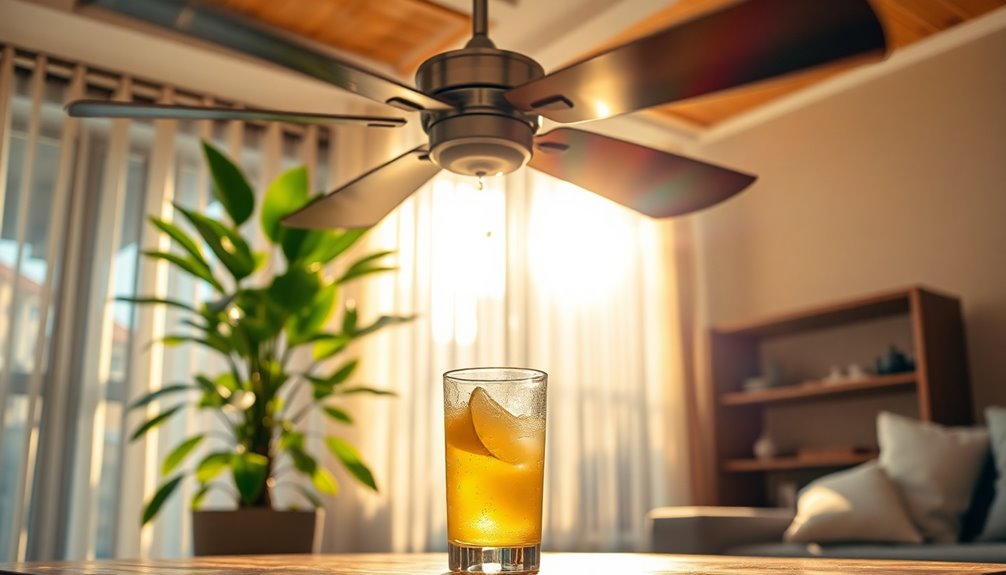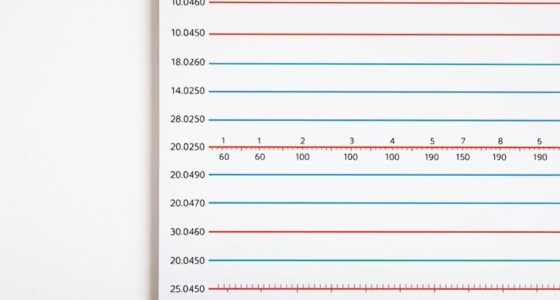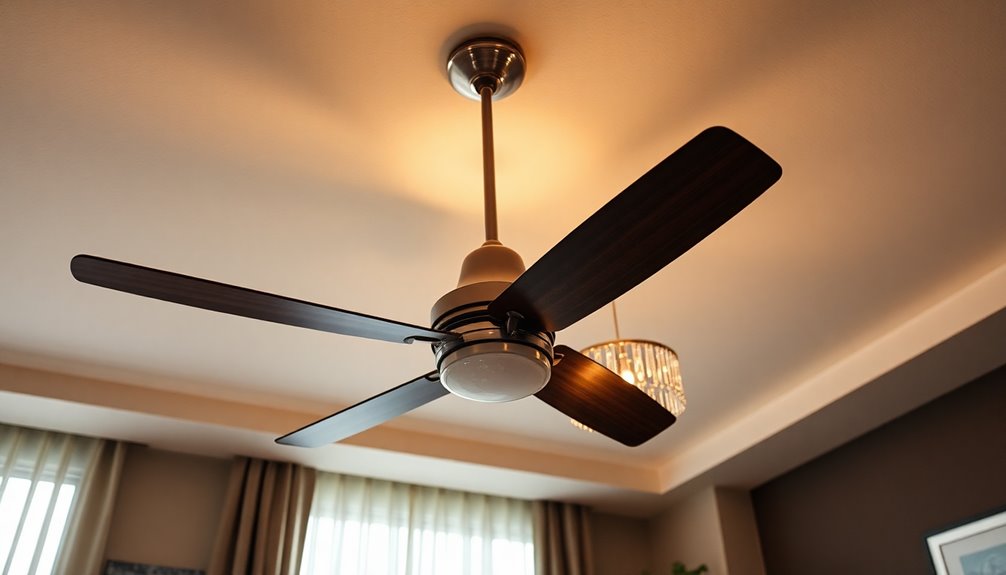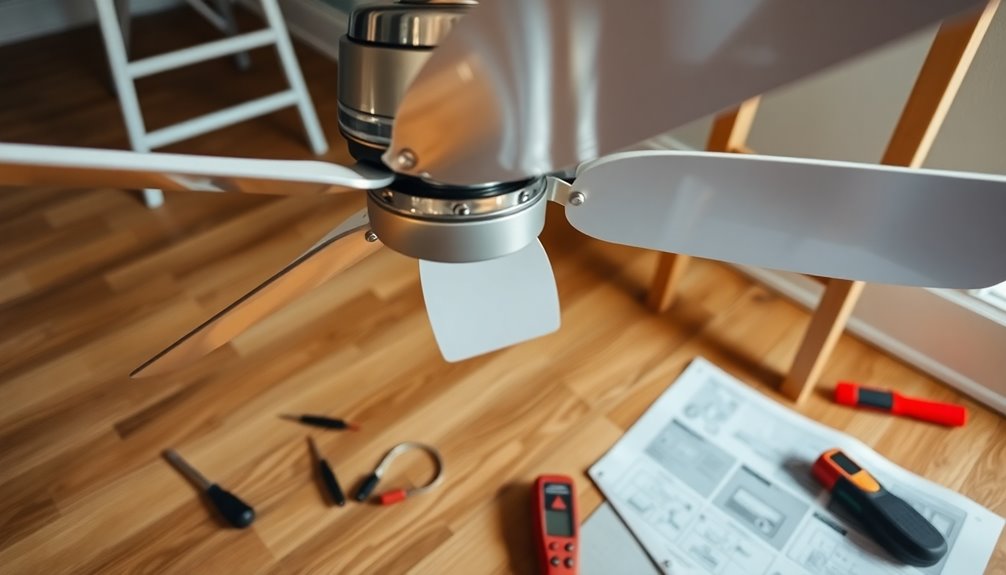Ceiling fans won't directly lower humidity levels, but they can make your space feel more comfortable. By creating airflow, they help reduce the damp sensation in the air. When running counterclockwise in warm weather, fans push cooler air down, which can alleviate the perception of humidity. While they don't extract moisture, they can prevent stagnant air and support other humidity control methods like dehumidifiers. So, if you're looking to enhance your indoor comfort and manage moisture better, there are various strategies to explore that could work for you.
Key Takeaways
- Ceiling fans promote air circulation, which helps reduce the perception of humidity in indoor spaces.
- They do not remove moisture but can aid in preventing stagnant humid air.
- Running fans counterclockwise in warm weather enhances cooling and comfort.
- Combining ceiling fans with exhaust fans improves overall moisture control.
- Fans complement dehumidifiers by maintaining airflow while dehumidifiers extract moisture effectively.
Understanding Humidity Levels

Understanding humidity levels is crucial for maintaining a comfortable living environment. Humidity, the amount of moisture in the air, should ideally range from 30% to 50% indoors. When humidity levels are too high, you may face issues like mold growth and respiratory problems, while low humidity can lead to dry skin and discomfort.
Factors such as temperature, air circulation, and moisture sources like cooking and bathing all influence your home's humidity. To effectively manage these levels, you can monitor them with a hygrometer, which helps you keep track of the moisture balance.
Improving air circulation is essential for reducing humidity. Good airflow can help disperse moisture and create a more comfortable atmosphere. You might consider using exhaust fans during cooking or bathing and ensuring your home is well-ventilated.
Additionally, appliances like dehumidifiers can help lower excess moisture when needed, while humidifiers can add moisture during dry spells. By staying proactive about your humidity levels, you can create a healthier and more pleasant living space for yourself and your family.
How Ceiling Fans Work

Ceiling fans operate by creating a consistent airflow that circulates air within a room, which helps you feel cooler and more comfortable, especially in warm weather.
The blades of ceiling fans rotate counterclockwise during the hotter months, pushing cool air downward. This creates a wind chill effect that reduces your perception of humidity, making the space feel less muggy.
In colder months, you can reverse the blades to rotate clockwise. This circulation helps distribute warm air that tends to rise near the ceiling, improving the overall temperature without increasing humidity levels.
Most ceiling fans come with adjustable speed settings, allowing you to control the intensity of air circulation based on your comfort needs and the humidity in the room.
While ceiling fans don't directly remove humidity from the air, they greatly enhance indoor comfort by promoting air movement.
This movement aids in faster evaporation from your skin and surfaces, which helps combat stagnant air conditions that contribute to high humidity.
Benefits of Air Circulation

Effective air circulation can greatly enhance your indoor comfort and overall well-being. By using ceiling fans, you promote airflow, which helps evaporate moisture and creates a cooling effect, making your space feel less humid.
You'll notice that increased air movement can greatly reduce the perception of humidity in your home, allowing you to feel more comfortable even on warm days.
When you run your ceiling fan counterclockwise during the summer, it circulates cool air downward, effectively reducing indoor humidity levels. This movement prevents the stagnation of humid air, minimizing the risk of mold growth and improving your indoor air quality.
It's a simple solution that can work wonders.
Additionally, ceiling fans can complement your Air Conditioning system. By using them together, you can create a more balanced indoor environment, which is especially helpful during those hot, humid months.
You can also combine ceiling fans with other humidity control methods, like dehumidifiers or even open windows, to further enhance air circulation.
Ceiling Fans vs. Dehumidifiers

When it comes to managing indoor humidity, fans and dehumidifiers serve different purposes. Ceiling fans help circulate air, creating a cooling breeze that can make a room feel less humid. However, they don't actually remove moisture from the air.
On the other hand, dehumidifiers are designed specifically to extract moisture, effectively lowering humidity levels in a more controlled and efficient manner.
While you might enjoy the comfort provided by ceiling fans, they only influence humidity in the immediate vicinity. Dehumidifiers, in contrast, can tackle humidity levels throughout an entire room or even your whole home. This makes them a better choice for preventing issues like mold growth and respiratory problems that often arise from high indoor humidity.
In situations where humidity levels soar, using both ceiling fans and dehumidifiers together can enhance your comfort and moisture control. The fan helps with air circulation, while the dehumidifier actively works to reduce humidity.
Tips for Using Ceiling Fans

To maximize the benefits of ceiling fans in managing humidity, there are several practical tips you can follow.
First, make sure your ceiling fans run in a counterclockwise direction during warm weather. This motion pushes cool air down, enhancing evaporation and helping to mitigate humidity effects.
For ideal humidity control, use your ceiling fans alongside open windows to promote cross-ventilation, improving overall air circulation in your indoor spaces.
Additionally, keep your ceiling fan blades clean; dust accumulation can trap moisture and worsen humidity levels, while also increasing noise.
Another effective strategy is to utilize ceiling fans with exhaust fans in kitchens and bathrooms. This combination helps remove excess moisture generated from cooking and bathing, further aiding in humidity control.
Finally, consider operating your ceiling fans continuously to maintain airflow. Stagnant air can lead to increased humidity and discomfort indoors, so consistent airflow is key.
Common Misconceptions

You might think ceiling fans can reduce humidity or lower the temperature in your room, but that's not quite true.
Instead of removing moisture, they simply circulate the air, creating a wind chill effect that makes you feel cooler.
Understanding these misconceptions can help you use your ceiling fan more effectively during warm months.
Ceiling Fans Reduce Humidity
Although many believe ceiling fans can directly reduce humidity, this isn't entirely accurate. Instead, they play a significant role in enhancing air circulation, which helps manage moisture levels in humid areas.
By promoting evaporation, ceiling fans prevent moisture from stagnating indoors, creating a more comfortable environment.
Here are four key points to keep in mind:
- Air Circulation: Improved air movement can help disperse moisture-laden air, making you feel cooler and less sticky.
- Wind Chill Effect: The sensation of coolness can potentially reduce your reliance on air conditioning, which is effective at lowering humidity levels.
- Exhaust Fan Combo: Pairing your ceiling fan with exhaust fans can effectively expel humid air generated from cooking or bathing.
- Regular Maintenance: Keeping fan blades clean guarantees peak air circulation, indirectly aiding in humidity control.
Fans Lower Temperature Only
Many people hold the misconception that ceiling fans actually lower the temperature in a room. In reality, they primarily create a wind chill effect that makes you feel cooler without changing the air temperature.
When you turn on a ceiling fan, it circulates air, promoting evaporation of moisture from your skin. This can enhance your comfort level, especially in humid conditions, but it doesn't decrease the thermal energy in the air.
While fans can make a room feel more pleasant, they don't reduce humidity levels. If you're in a particularly humid environment, the cooling effect of the fan mightn't be enough to counteract the discomfort from high moisture levels.
It's essential to recognize that ceiling fans don't actively dehumidify the air. For effective humidity management, you'll need to take into account using dehumidifiers or ensuring proper ventilation alongside the fan.
Other Humidity Control Methods

Effective humidity control goes beyond just ceiling fans; there are several methods that can help maintain a comfortable indoor environment.
If you're dealing with humid air and excess moisture, consider these options:
- Exhaust Fans: Use exhaust fans in your kitchen and bathroom. They effectively expel warm, humid air outdoors during cooking and showering, keeping indoor humidity levels lower.
- Whole-Home Dehumidifier: Installing a whole-home dehumidifier can provide thorough moisture control. It integrates with your HVAC system to reduce humidity throughout your entire house.
- Natural Desiccants: Utilize natural desiccants, like baking soda or activated charcoal, in strategic locations. They can absorb excess moisture, providing an inexpensive temporary solution.
- Regular Maintenance: Don't forget to schedule regular maintenance for your air conditioning system. This not only guarantees efficient cooling but also enhances its dehumidification capabilities.
Frequently Asked Questions
Do Ceiling Fans Help With Moisture?
Ceiling fans don't directly remove moisture from the air, but they can certainly help manage it.
When you run your ceiling fan, you improve air circulation, which aids evaporation from your skin and surfaces. This process can make the room feel cooler and more comfortable.
By preventing stagnant air, you create a more pleasant environment.
Just remember to keep your fan clean and well-maintained for peak performance in managing moisture.
Do Ceiling Fans Make Air Dry?
Ceiling fans don't dry out the air, but they do deliver delightful drafts.
You'll feel cooler as they circulate air, creating a revitalizing breeze that makes you think it's drier. However, they don't actually remove moisture from the air.
Instead, they simply stir things up. For true dryness, you'll need to combine fans with dehumidifiers.
How Do I Lower the Humidity in My Room?
To lower the humidity in your room, you can start by using exhaust fans when cooking or bathing; they'll help push out warm, moist air.
Consider running a dehumidifier for effective moisture control and keep windows slightly open to encourage airflow.
Limiting hot showers and checking for leaking pipes are also key steps.
Which Way Should Ceiling Fans Go for Humidity?
To manage humidity effectively, you should set your ceiling fan to rotate counterclockwise during warm months. This direction creates a cooling breeze that helps evaporate moisture from your skin.
In cooler months, switch it to clockwise; this pushes warm air down and maintains comfort without adding to humidity levels.
Regularly check the fan's direction to optimize airflow and prevent stagnant air, which can increase humidity and lead to mold growth.
Conclusion
In the battle against bothersome humidity, ceiling fans can be your trusty allies. They circulate the air, creating a revitalizing breeze that makes the air feel cooler, even if it doesn't directly remove moisture. By dancing through your space, they help you feel more comfortable. Pairing them with other methods, like dehumidifiers, can enhance your home's haven. So, spin your ceiling fans and savor the sweet relief from sticky, sultry air!









